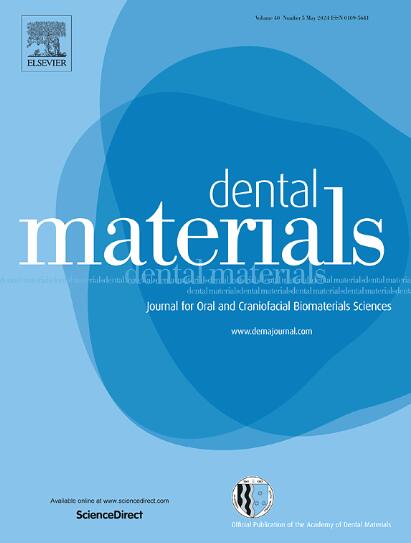Multicenter RCT 5-year survival of screw-retained Cerec chairside-made hybrid abutment posterior ceramic crowns
IF 6.3
1区 医学
Q1 DENTISTRY, ORAL SURGERY & MEDICINE
引用次数: 0
Abstract
Objectives
To evaluate the survival and success at 5 years of Cerec fabricated screw-retained hybrid abutment posterior ceramic crowns made in one chairside session using perforated blocks as compared to PFM crowns.
Methods
Between 2015 and 2023 a multicenter RCT including 7 sites followed 90 implant screw-retained crowns distributed on 45 molars and 45 premolars. The crown materials were PFM/gold abutment (G0, N = 30), lithium disilicate (Li2Si) IPS e.max CAD (G1, N = 30) and polymer infiltrated ceramic network, (PICN) VITA Enamic (G2, N = 30), bonded on titanium bases (TiBase). Patients were recalled once a year. Mechanical outcomes included fracture (F) for which recovered parts were analyzed using fractographic means, partial (PD) or full debonding (FD) and screw loosening (SL). Survival included critical events needing crown replacement. Success included critical and non-critical events. Kaplan-Meier survival estimates and log-rank (Mantel-Cox) test for significance at 95 % confidence level and intervals were calculated.
Results
Survival: G0 93.3 % (2 F), G1 100 %, G2 31 % (2 F, 9 PD). Success: G0 86.7 % (2 F, 2 SL); G1 93.1 % (2 SL), G3 25.4 % (2 F, 10 PD, 1 FD, 2 SL). Partial debonding was significantly more prevalent in PICN than Li2Si (P < 0.01), occurring between the third and fifth year of observation. No statistical differences for operator-related failures were found. Enamic full thickness fractures occurred after 3.3 and 3.8 years. PFM chip fractures at years 1 and 5.
Significance
Within the limits of this study, data suggests that the Cerec fabricated hybrid abutment Enamic crowns bonded to Dentsply Sirona TiBase abutments in one chairside session are not recommended due to the high incidence of non-recoverable partial debonding events. IPS e.max CAD hybrid abutment crowns, on the contrary, performed very well in this RCT. Our findings, however, are limited to the specific set-up of Cerec hybrid abutment crown fabrication and should not be extrapolated to other existing digital workflows, titanium bases and nonperforated ceramic blocks for hybrid abutment crowns.
螺钉保留Cerec椅制混合基台后牙陶瓷冠5年生存率的多中心RCT研究。
目的:评估Cerec制造的螺钉保留混合基牙后牙烤瓷冠与PFM烤瓷冠在一次椅子旁使用穿孔砌块制作的5年生存率和成功率。方法:2015 - 2023年,采用7个部位的多中心随机对照试验,对分布在45颗磨牙和45颗前磨牙上的90个种植体螺钉保留冠进行随访。冠材料为金属烤瓷/金基台(G0, N = 30)、二硅酸锂(Li2Si) IPS e.max CAD (G1, N = 30)和聚合物渗透陶瓷网络(PICN) VITA Enamic (G2, N = 30),结合钛基(TiBase)。病人每年被召回一次。力学结果包括骨折(F),使用断口学方法分析恢复的部件,部分(PD)或完全剥离(FD)和螺钉松动(SL)。生存期包括需要置换术的关键事件。成功包括关键事件和非关键事件。Kaplan-Meier生存估计和log-rank (Mantel-Cox)显著性检验在95% 置信水平和区间进行计算。结果:生存率:G0 93.3 %(2 F), G1 100 %,G2 31 %(2 F, 9 PD)。成功率:86.7 %(2 F, 2 SL);G1 93.1 % (2 sl), g3 25.4 %(2 f, 10 pd, 1 fd, 2 sl)。部分脱粘在PICN中明显比Li2Si更普遍(P 意义:在本研究范围内,数据表明,由于不可恢复的部分脱粘事件的高发生率,不建议在一次椅侧会议中使用Cerec制造的混合基牙牙釉质冠与Dentsply Sirona TiBase基牙结合。与此相反,IPS e.max CAD混合基冠在本RCT中表现良好。然而,我们的研究结果仅限于Cerec混合基牙冠制造的特定设置,不应推断到其他现有的数字工作流程,钛基牙和混合基牙冠的无孔陶瓷块。
本文章由计算机程序翻译,如有差异,请以英文原文为准。
求助全文
约1分钟内获得全文
求助全文
来源期刊

Dental Materials
工程技术-材料科学:生物材料
CiteScore
9.80
自引率
10.00%
发文量
290
审稿时长
67 days
期刊介绍:
Dental Materials publishes original research, review articles, and short communications.
Academy of Dental Materials members click here to register for free access to Dental Materials online.
The principal aim of Dental Materials is to promote rapid communication of scientific information between academia, industry, and the dental practitioner. Original Manuscripts on clinical and laboratory research of basic and applied character which focus on the properties or performance of dental materials or the reaction of host tissues to materials are given priority publication. Other acceptable topics include application technology in clinical dentistry and dental laboratory technology.
Comprehensive reviews and editorial commentaries on pertinent subjects will be considered.
 求助内容:
求助内容: 应助结果提醒方式:
应助结果提醒方式:


